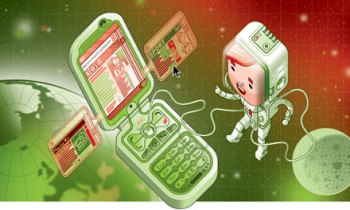The Next Big Thing in Mobile: 5 Trends We're Watching

Last week I participated on a panel for the Commonwealth Club of California on Microsoft’s Mountain View campus called The Next Big Thing in Mobile. It was moderated by the very engaging Jon Fortt, Senior Writer, Technology for Fortune and included a diverse and talented group of wireless experts:
• Glenn Lurie, President, Emerging Devices Organization, AT&T
• Tim Attinger, Global Head of Product Innovation and Development, Visa Inc.
• Arun Bhikshesvaran, SVP, Multimedia and Infrastructure Solutions, Ericsson Inc.
• Ali Diab, Vice President of Product Management, North America, AdMob
• Peter Hoddie, Co-Founder and CEO, Kinoma
The panel was one of the best attended in Commonwealth Club history and based on the enthusiasm from the audience we could have kept going for hours. My experience at the event prompted me to take a moment to organize a few of the overarching mobile trends that Allison Mooney and the team at Next Great Thing/MobileBehavior have been writing about recently:
1. Socialization
Unlike the PC, which was driven by the needs of businesses, mobile has always been first and foremost a vehicle for socialization. You can really see this coming to life recently with the rise of "prescriptive social software" applications like Booyah and Foursquare that focus so heavily on socialization to drive user behavior and turn life into one big game.
2. Real-Time Mobile Activation
The mobile phone can seamlessly function as a mouse and make any location or out-of-home media instantly actionable. For young people, mobile is the bridge for digital to real-life in real-time. It sits at the center of their world and connects them back to social media, lifestreams, and all of their media. Recently we launched a program with Locamoda for Demi Lovato’s Summer Tour that illustrated this perfectly. The Wiffitti mobile social messaging application that we are using on the tour enables concert fans everywhere to interact and be part of our digital out-of-home media in real-time regardless of their location.
3. Branded Utility
Mobile applications, especially those on the iPhone, have now become the preferred mobile path for marketers. However, a mobile presence, even if it is an application, can be useless if it is not truly integrated into a larger mobile plan. So, to stay relevant and be successful via mobile, brands must become useful. One way to do this is through branded utility--focusing on enhancing “this moment” and creating a continuous 2-way brand-to-consumer, consumer-to-brand value chain that evolves via consuming, activating, and sharing. Zagat’s new augmented reality application is a great example of this as they are effectively using AR to enhance and encourage participation with the restaurant search experience in real-time.
4. ME Advertising
Mobile is ushering in the dawn of “ME” advertising that is proximate and personal. Search is no longer fueled by code, but by like-minded users and friends who act as curators. This is creating an entirely new brand value chain, ROI and branded messaging via mobile that is rapidly becoming a real-time endorsement channel. We can already see this starting to take-off through real-time search services like BingTweets, Collecta, and OneRiot.
5. Mobile Cloud Computing
Cloud Computing is destined to become the standard for mobile phones, and while devices today are still relying on their internal memory and CPU capacity, all of this is rapidly transitioning to the web. Google’s investment into Chrome and their move onto campuses, along with Apple sales, presages a future for mobile where software will matter more than the device itself. When applied to mobile, Cloud Computing is ushering in a new future for Internet-based computing. It will allows for increased collaboration through open APIs, and access to research, analysis, mobile marketing services, and software services without investing in IT. Going forward, this will enable a true focus on the customer and the brand, not on the technology.








